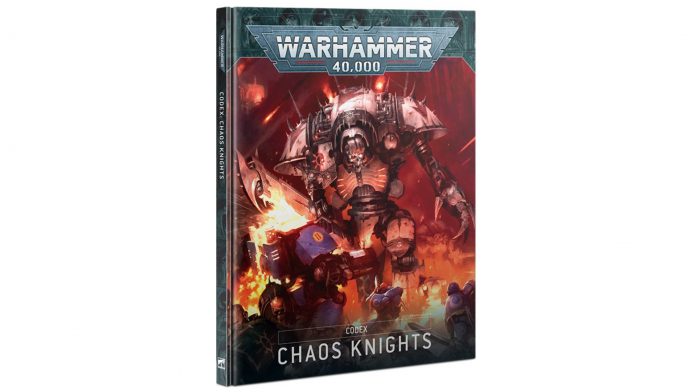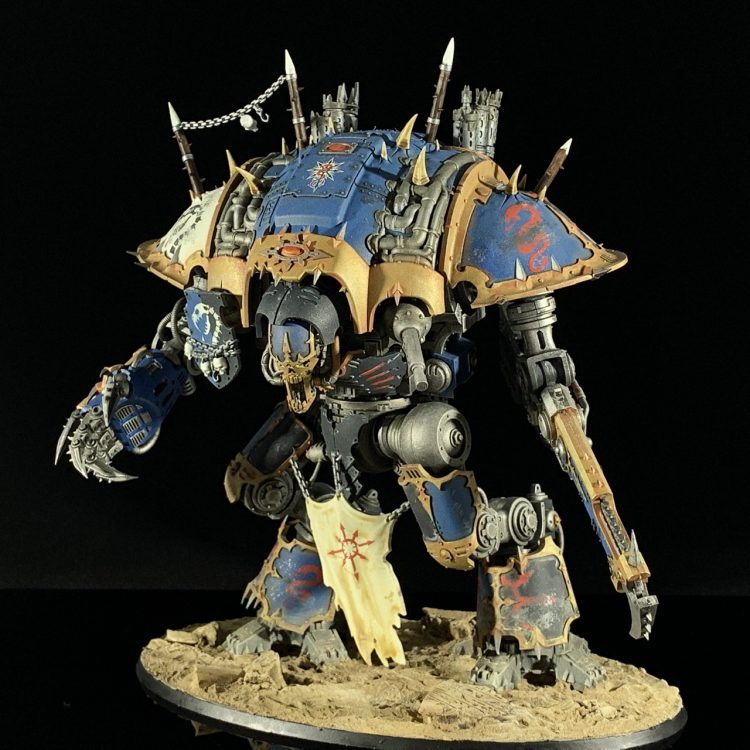Chaos Knights seemed like an afterthought when they originally released in the summer of 2018 but four years later they’ve changed dramatically – the release of the 9th edition Codex: Chaos Knights sees them add two new models to their range and a host of new rules and abilities Much like how Ken and Ryu grew apart in Street Fighter over the years, Chaos Knights are a now their own wholly distinct faction from their imperial counterparts and we couldn’t be happier to see it. In today’s review we’ll be talking about the new Chaos Knights Codex, what’s in the book, and how you can use it for your games. If you’re interested in the new limited edition boxed set that includes the Codex, you can find our review of that here. If you’re looking for a review of the Crusade rules, check back Tuesday for those.
Before we begin we’d like to thank Games Workshop for providing a preview copy of the book, plus some of the models seen in the review.
Why Play Chaos Knights?
The short answer is: Because knights are rad, but the Imperium is lame. The longer answer is that Chaos Knights now have a ton of variety and options for play, and are the most fun army in the game to model, convert, and paint. The kits are huge and wildly customizable, and the rules in the new Codex give you a ton of options, including the ability to dedicate your knights to the Dark Gods of Chaos. The rules are also a huge step up, giving Chaos Knights players lots of great options with some real power behind them. Finally, the new Dreadblade rules make it easy to include a single knight or trio of War Dogs in any Chaos army, which is a great way to improve a force.
What’s in this Book?
- Lore for the Chaos Knights, with backstory on Dreadblades, Iconoclast households, and Infernal households.
- A ton of new art that looks fantastic. Normally I wouldn’t talk about this but there’s so much amazing stuff here and it makes the 8th edition book look like a sorry little pamphlet.
- Rules for constructing and playing with a Chaos Knights army, including rules for including a single Dreadblade unit in a Chaos army.
- The Dread Households, powerful fallen knight households, each with their own rules, warlord traits, relics, and stratagems.
- Harbingers of Dread, a powerful new ability for Chaos Knights armies that allows them to sow fear and dread into their enemies, leaving terror in their wake.
- Rules for dedicating your knights to the Ruinous powers, with three abilities each for dedicating them to Khorne, Slaanesh, Nurgle, Tzeentch, and the Pantheon Undivided.
- All the relics, stratagems, traits and secondary objectives you’d expect from a 9th Edition Codex.
- An especially deep set of Crusade Rules, providing rules for infernal quests and very granular Battle Traits and Scars that can be applied both to your pilots and the Knights themselves.
- Datasheets for all the Chaos Knight units, including a host of new datasheets for the new Knight Abominant and War Dogs models.
The Five Best Things About This Book
- New Chaos Knights: The new Chaos Knight models are great, and the rules for them are also pretty exciting. Players should find plenty to love with their new options.
- A Distinct Flavor: Chaos Knight armies get two new kits while their Imperial cousins get none! Suck it, Imperial lapdogs. On top of that, the Chaos Knights really do feel like a different army now rather than just spiky knights, which is great.
- The Abominant. The new Chaos Knight is a psyker, and the Warp Storm Discipline has some powerful tricks in it. It’s also something that Imperial Knights just don’t have.
- Harbingers of Dread. The new dread rules represent the effect Chaos Knights have on the battlefield, darkening skies as warp storms creep in and their enemies are driven mad with fear. These aura-like abilities let you customize how that affects the battlefield and they’re pretty strong.
- Favour of the Dark Gods. Dedicating your knights to one of the Chaos Gods is just the coolest thing, and something we’ve been waiting for. The new rules don’t disappoint, and they open up a host of awesome modeling opportunities.
Where’s Crusade?
As always, our narrative team are hard at work preparing a Crusade review for this book, which will be published on Tuesday. There’s a very detailed system for chronicling your fallen princeps’ paths to damnation and it’s the most RPG-like set of rules we’ve seen yet.
The Rules
For a book with so few datasheets, Chaos Knights have a lot of rules now. That’s to be expected, as they’re a bit of a unique type of army for 40k (well, them and Imperial Knights), and need some extra rules to accommodate that.
Detachment Rules
As an army made up entirely of Lords of War, Chaos Knights have a fairly unique set of detachment abilities to ensure their lists function as you’d expect.
Up front, Chaos Knights get a specific exemption to the general rule that Super Heavy Auxiliary detachments do not qualify for Detachment Abilities – so a solo Knight (or trio of War Dogs) will benefit from rules in this section as long as they meet any other criteria. That’s particularly important for Combat Patrol, as without it you’d be running three War Dogs with no abilities.
Any Chaos Knights detachment gains a number of abilities discussed below, and any War Dogs within the detachment gain Objective Secured (because they’re the closest thing you have to Troops).
Traitoris Lances
Traitoris Lances addresses two key issues that Chaos Knight armies have: The first is that Super Heavy Detachments are expensive, and Chaos Knights have no specific “character” datasheets to bring along as their Warlord or to give relics.
This rule levels the playing field, and will be somewhat familiar to players from 8th Edition (though it has changed a bit). First up, for each Super Heavy Detachment (or your single Super Heavy Auxiliary Detachment, in Combat Patrol specifically) you get to pick one War Dog-class, Abhorrent-Class, or Tyrant-Class Chaos Knight (i.e. no Forge World) to be a CHARACTER, which means they can then be your Warlord and be given a relic (other options for this exist in Stratagems, of course).
In addition, depending on the composition of your Super Heavy Detachment, you get a discount on the CP cost for the detachment as long as it contains your Warlord. If the detachment contains at least one Abhorrent-Class model or three War Dogs, you get 3 CP back, while if you have either three Abhorrent-Class models or 6+ War Dogs accompanying at least one TITANIC unit, you get the full 6 CP refunded.
This is handy, but a bit harsher than the rule as it has been so far in 9th, where just having a TITANIC Warlord fully refunded the cost. You will still find that you get the full 6 CP refund a lot of the time, but there’s now one specific setup where you might not, which is one Tyrant-Class Knight (or Cerastus from Forge World), two Abhorrent-Class and 3-4 War Dogs to fill. As a general trend in both this book and the Imperial one, including Tyrant-Class Knights in your list comes with tradeoffs, both costs like these and reduced compatibility with Relics and buffs. This tentatively, feels like a pretty smart piece of design, as it allows the point price tag of the Tyrants to stay reasonable, and the balance of Relics to be more precisely tuned, but it does make bringing a Tyrant along feel like a weightier choice.
Towering Foe
As foretold in the Balance Dataslate, Chaos Knights get a huge bonus to objective control – War Dogs count as five models for the purposes of controlling objectives in addition to getting ObSec, while TITANIC Chaos knights count as ten models. This is super strong, and avoids opponents being able to outplay you on the Primary just by gradually sacrificing ObSec chaff on the edge of an objective – they have to actually fight back!
Traitoris Ambitions
Chaos Knights have two different replaceable keywords, the <QUESTOR TRAITORIS> keyword and <DREAD HOUSEHOLD>, and both of these give them a faction trait. Traitoris Ambitions are chosen to replace Questor Traitoris, applying to any non-Dreadblade models in a Chaos Knights Detachment where all knights have the same allegiance. There are two Ambitions to pick from: Iconoclast Household and Infernal Household. As well as a trait for your units, the two allegiances get some separate options for relics and stratagems, and a completely different set of Fell Bonds.
The Traitoris Ambitions here are the same as in the 8th edition book – Iconoclast and Infernal, and while the Iconoclast trait hasn’t changed, Infernal saw some tweaks.
Iconoclast Households: Conquerors Without Mercy
Models with this ambition get +1 Attack and improve their AP by 1 when they fight, as long as they charged, were charged, or made a Heroic Intervention this turn. This makes them the go-to option for melee-focused knights, where every additional attack can turn into 2 or 3 when you start fighting in sweep mode. It’s also by far the less complicated of the two Ambitions from a headspace standpoint, but it’s a very solid bonus.
Infernal Households: Daemonic Surge
Models with this ambition draw on daemonic energies to fuel their rampages. In each of your Command phases, each model with this Ambition can use a Daemonic Surge. If they do this you can either take one mortal wound and roll a D3 to determine the effect you get until your next Command phase, or you can take D3 mortal wounds to choose the effect. The effects are:
- Add 3” to your move characteristic
- Each time an attack is made against the model, an unmodified wound roll of 1-3 always fails
- Pick a weapon the model has, attacks with that weapon get +1 to wound
There’s a lot of power here, with the tradeoff that you’ll be wounding your models every turn to maximize their power in interesting ways.
Each Chaos Knight also belongs to a <DREAD HOUSEHOLD>, and each <DREAD HOUSEHOLD> is locked-in to one of the two ambitions. As long as a detachment has at least three models, and all your Knights are from the same Dread Household across your whole army (which they have to be in Warzone Nachmund anyway), then it becomes a Dread Household detachment, and you get access to a faction trait (called a Household Bond), Warlord Trait, Stratagem and Relic. If none of the named houses are your jam, you can take a single Fell bond instead, chosen from a list of 8 for each of the the Traitoris Ambitions, which gives you a trait but little else.
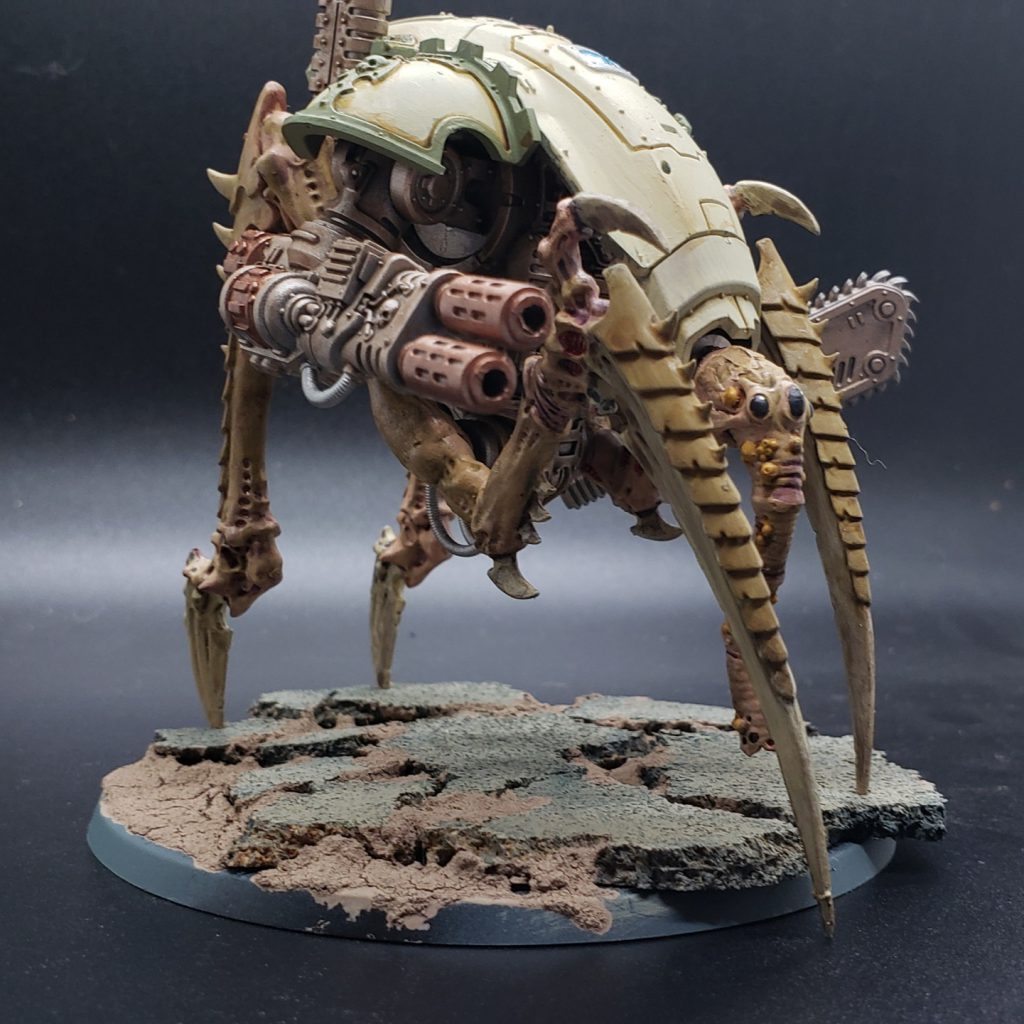
Dreadblades
If the rules seemed relatively simple up to this point well, strap in. All of this gets complicated by the existence of DREADBLADES, mercenary Chaos Knights that aren’t part of any Household, but can be included in your detachments. By and large, these don’t break the other rules (with the exception that a Dreadblade with the wrong Traitoris Ambition in a detachment will break the Ambition for other models), but don’t count towards them, either. A Dreadblade never gains a Traitoris Ambition, and doesn’t count as one of the three models in a detachment towards it gaining a Household Bond (but doesn’t stop it becoming one either). Instead, each Dreadblade unit in your army indepedently picks a unique Fell Bond from the appropriate list to apply just to them, even if there are fewer than three Dreadblades in the detachment.
Dreadblades also have a special option if you want to include them in other Chaos armies – you can use the new Fallen Hero rule to add a single Dreadblade to your army. This applies to a Super Heavy Auxiliary detachment containing a single DREADBLADE unit, and grants them the AGENT OF CHAOS keyword, which generally means they won’t break access to army-wide abilities or Secondary objectives, meaning you can include a Dreadblade in your Death Guard army without losing Contagions. What’s more, because you can mark your Dreadblade to devote them to the same god, you can give them a keyword they’ll share with the Warlord, allowing you to refund some CP for the detachment!
While you’re obviously still going to sacrifice some amount of synergy to do this, there definitely are builds out there that would benefit from a gigantic robot (or three smaller, ObSec ones – this rule is Unit not Model – so a trio of War Dogs absolutely counts), so keep this in mind.
Robnote: There are some issues with how this rule is worded but we believe the correct interpretation is that a Super-heavy Detachment with a single dreadblade is intended to also be a Chaos Knights detachment.
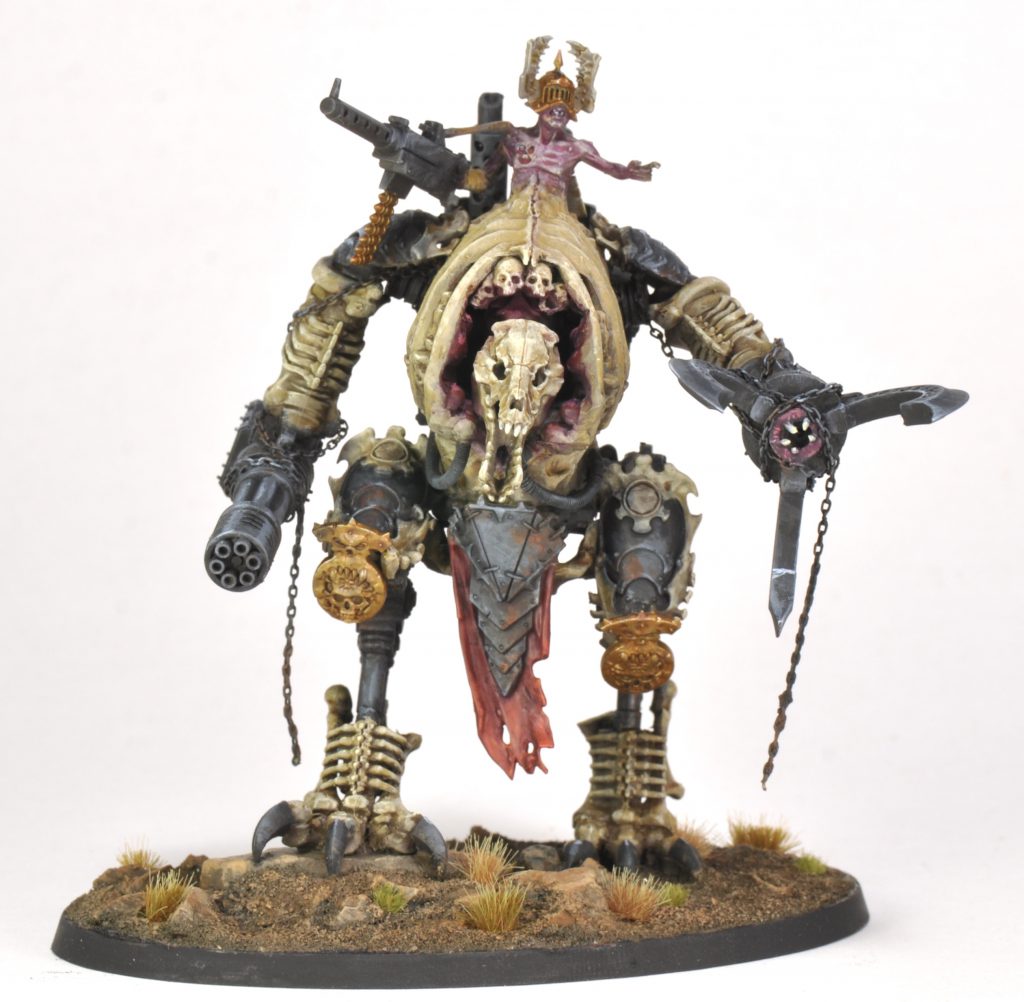
Army-wide Rules
Harbingers of Dread
When the Chaos Knights show up on the battlefield, shit gets real. The skies darken, the earth shakes, warp storms swirl overhead, and a visceral sense of dread and foreboding grip their enemies, paralyzing them with fear. If every unit in your army has the Chaos Knights keyword (excluding Unaligned units or Agents of Chaos), then those units gain a bonus depending on which abilities are active. This is similar to many of the battle round-based abilities we’ve seen in 9th edition codexes, giving you escalating bonuses each battle round
Dread Abilities
Before we get into this we need to talk about Dread Abilities, the new abilities in the book, which are marked with a little skull. These are like Auras, in that they affect units within Dread Range – 12” at the start of the battle – and do not stack if identically named, but like Contagions are not actually Auras, nor are they affected by things that affect auras.
So let’s talk about Harbinger abilities. Your army starts in Doom mode, the middle of the three tracks – Despair, Doom, and Darkness – and each round you choose a single ability from these three to become active for the rest of the game. Abilities are cumulative, and while you can go from Doom (the middle) to Despair or Darkness each round, you can’t go from Despair to Darkness, or vice versa. You also have to end on Doom in round 5, so in between you’ll have nine options to choose from on battle rounds 2, 3, and 4.
On Round 1, you start with the Dread Host ability, which gives enemy units within Dread range (12”) -1 to their Leadership and -1 to Combat Attrition tests. This sounds worse than it is, in part because there are quite a few choice abilities in Codex: Chaos Knights that key off leadership and even getting -1 is a big improvement when it takes a unit from 7 to 6. Many abilities will require a unit to take a Dread Test, which has them roll 2D6 and attempt to roll equal to or under their Ld value in order to pass.
Then on Round 2 you get to choose how you’ll proceed, and this will vary by enemy. I’m not going to go through all 9 options here, but I’ll give you a general idea of one path I might take. On Round 2 I really want to provide cover for my melee War Dogs so I activate Gheist Storm, which makes it so that any time a unit within Dread Range wants to shoot, they have to take a Dread Test. If they fail, they can only shoot the closest eligible Chaos Knights unit and if they charge any Chaos Knights units, those results are halved. Given that War Dog Karnivores move 14” and can push Dread Range from 12” away, this is a powerful deterrent, especially if I can make it work from behind a wall.
On Round 3 I’m closing the distance and ready to get into melee. Rather than stay in Darkness and get a -1 to be hit from more than 12” away, I opt to switch back to Doom for Mortal Terror, which causes an additional model to flee every time a unit fails a morale test in Dread Range, and if the target rolls double their highest Ld, D3 models flee instead. This is in part because I’m trying to get back to Despair.
On Round 4 I jump to Despair, in order to take Paralyzing Insanity, one of the strongest effects in the book. Units in dread range lose Objective Secured. This helps my War Dogs clean up on objectives, denying my opponent VP out of nowhere – the ability goes into effect at the start of the battle round, so if they’re going first they may find they are suddenly scoring 0 VP for the turn – and ensuring I can clean up.
Then on Round 5 I’m back to Doom for Horror of the Warp, which gives enemy units within Dread Range another -1 to their attrition tests and forces 2 models to flee instead of 1 each time they roll an unmodified 1 for attrition.
Of course, what you’ll take here will vary wildly depending on the opponent, but you have a series of interesting options whether your goal is to grind out a slow board control win or execute a bloody massacre in your opponent’s backfield. Because these abilities are cumulative, there’s a bit of reward here for more conservative play, where you slowly grind out an opponent’s units, but enough flexibility that you can be aggressive when you need to and take hordes off the table through sheer attrition, which is cool.
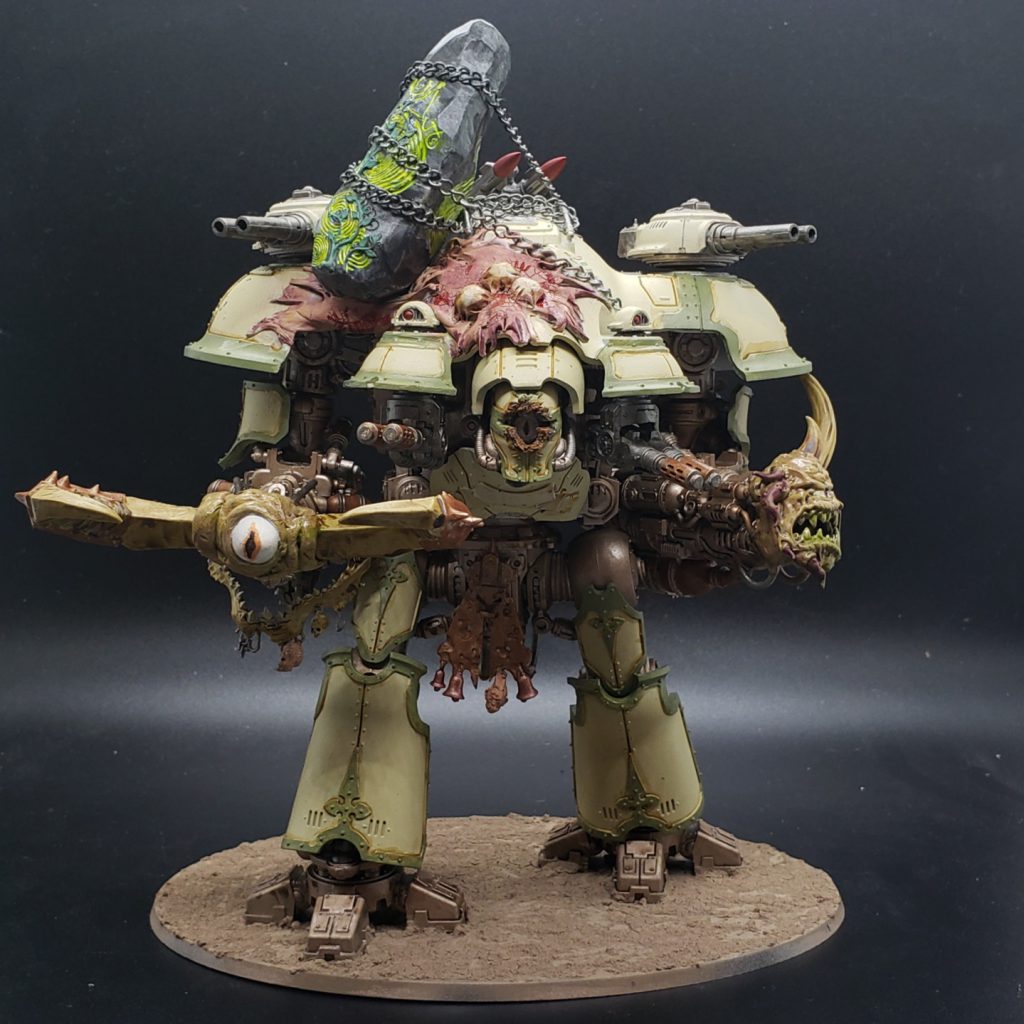
Favour of the Dark Gods
Finally, at long last, we can mark our Knights as servants of the pantheon. Dedicating a knight to one of the dark gods costs points – typically between 15 and 60 – with bigger knights usually costing more to mark (with the exception of some of the melee-focused buffs being a bit cheaper on Tyrants than Abhorrent). Each god offers three different favours (plus three more for the Pantheon Undivided), and you can only have each favour in your army once. Each favour gives you a specific keyword – this is how you get knights with the NURGLE keyword for stratagems and others – and provides a special ability.
On top of the base ability each favour gives you, each one has a second favoured ability that can be activated after you provide a worthy offering to the god in question. How do you do that? By destroying models. Each model you destroy a model, you add a number of tallies equal to its wounds characteristic. Get a certain number – 5 if you’re a War Dog, 10 if you’re Abhorrent-class, or 15 if you’re a Tyrant – and at the end of the phase you gain the favoured ability. This is pretty easy to hit, and some of the favoured abilities are pretty great. Let’s look at some of them.
Khorne
The Khorne abilities are all about melee combat. If you give one of these to the Psychic Knight Abominant, it loses the Psyker keyword but improves its WS by 1 and gains an extra attack, helping turn it into more of a melee threat. The Throne Mechanicum of Skulls lets your knight re-roll charges, and if it’s favoured you’ll get extra hits on exploding 6s, which can be pretty nasty when making sweep attacks. My favorite favour here however is the Blood Shield, which can be activated once per battle during the Fight phase to turn off invlunerable saves against melee attacks for the bearer and any targets it attacks. Gain Khorne’s Favour and you can activate it a second time. This is great for plowing through all those smug fools who think they can tank your attacks with a 4+ invulnerable save, and you can avoid the downside by just killing whatever you fight.
Tzeentch
The Tzeentch abilities are more about trickery, but it’s worth noting the Pyrothrone here, which turns any knight into a Psyker who cna cast/deny one power. If you toss it onto a Knight Abominant, then they know an extra power and can cast an extra power per turn. Gain Tzeentch’s Favour and you can re-roll one psychic test per turn for the model. If Psykers aren’t your thing, then the Cursed Rune of Fate may be more your speed – every time a ranged attack is made against you, if you save on an unmodified 6, the attacker takes a mortal wound. Gain Tzeentch’s Favour and you’ll get a 4+ invulnerable save, increasing your durability.
Nurgle
Nurgle’s gifts are more about durability. The Putrid Carapace gives you +1 on saves against attacks that are 1 damage, and with Favour you get +1 Toughness. Aura of Corruption is my favorite, though – it gives you a 6” Aura that reduces enemy Strength by 1. Gain Nurgle’s Favour however and it gains a second 6” Aura that reduces enemy Toughness by 1. I particularly love how this can stack with Contagions if you take the knight as a Dreadblade in a Death Guard army. The Blessing of a Thousand Poxes also deserves mention for only costing 15pts on a Tyrant, making it a very cheap way to gain access to Nurgle’s Stratagem (act on full wounds) on a big Knight.
Slaanesh
Slaanesh-marked knights have some really interesting abilities, primarily based around movement. The Quicksilver Throne lets a knight perform Heroic Interventions as a Character and lets it fight first in the Fight phase. Gain Slaanesh’s Favour and you’ll be able to Consolidate D3+3” instead of 3”. If you want something a bit trickier, there’s Subjugator Machine Spirit, which replaces your knight’s machine spirit with one from one of these war machines, causing you to count as having remained Stationary in the Shooting phase if you Advanced, or Fell Back. Gain Slaanesh’s favour and you can charge after Falling Back or Advancing. This is maybe the nastiest trick in the book, since it creates situations where you can plow forward with a knight, advance, shoot a unit off the table, gain the favoured ability, and then charge into an unsuspecting opponent!
Pantheon Undivided
If you just can’t choose a favorite chaos god, there’s the pantheon undivided, which mostly offers durability and movement buffs. Mark of the Dread Knight gives you 6+ feel no pain roll that can upgrade to a 5+. Warp-Borne Stalker lets you deep strike a knight, and with the upgrade you can pick the knight up and deep strike him again one turn later. And the most powerful favour in the book is arguably Blessing of the Dark Master, which makes it so opponents can’t re-roll hits, wounds, or damage against your knight. Gain the favour of the dark gods however, and attackers won’t be able to hit your knight on rolls of 1-3, regardless of BS or abilities they have!
These are some incredibly cool and powerful abilities, and one of the more interesting things about them is how they work with Dreadblades – by being able to give your dreadblades a god-specific keyword, you can ensure that your detachment has a keyword from NURGLE, TZEENTCH, KHORNE, or SLAANESH, allowing you to potentially get back 2 CP from your Dreadblade detachment sharing a keyword with your army’s warlord that isn’t CHAOS. You won’t always want to do this, but it can be a strong bonus in something like a Death Guard army where you not only retain the CP but also make your knight immune to many daemon engine explosions. Robnote: Retaining the CP at the moment depends on whether the added keywords for gods are Faction keywords or not. Currently, the pantheon keywords are almost exclusively Faction Keywords but as this doesn’t specify, it’s a bit ambiguous, so it remains to be seen if you can get your CP back. On a different unrelated note, we’d like to thank “Rat-Snitch Craig, the Good-Time Ruiner” for pointing this out.
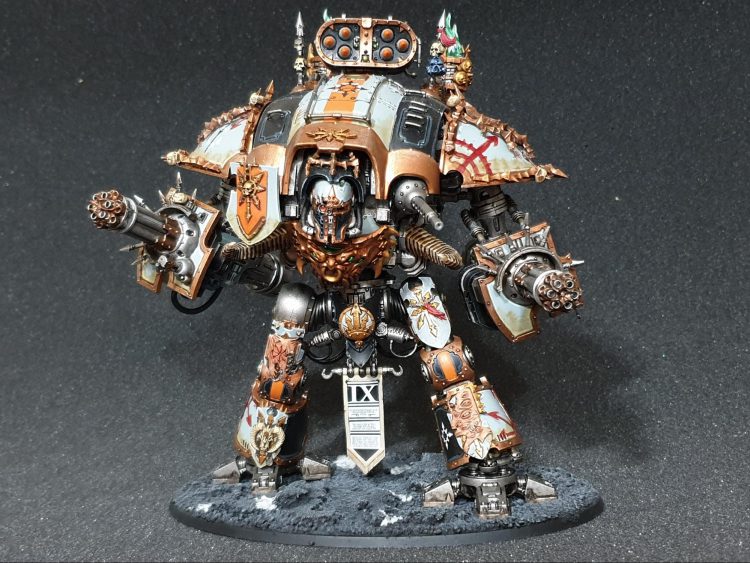
Subfactions
Imperial Knights have noble houses of knights, Chaos Knights have fallen houses of their own. There are six of these in total – 3 Iconoclast and 3 Infernal.
House Herpetrax
The first Iconoclast House, Herpetrax War Dogs get +2 wounds, while bigger knights get +4. That’s probably an extra shot worth of durability with some of the bigger weapons. Their Stratagem, Warping Presence, can do mortal wounds to each enemy unit within 6” at the end of the Fight phase, while their Warlord Trait allows a knight to ignore bracketing, modifiers to hit, wound, or damage rolls, and modifiers to movement when Advancing or Charging. The relic gives the bearer -1 to be hit, but can’t be taken on Tyrants. Overall it’s not bad, and the extra wounds are a nice touch, while the ability to ignore modifiers will help you get the most out of your limited models.
House Lucaris
The second Iconoclast household, the Lucaris household bond lets a knight re-roll one hit or wound roll when making melee attacks, playing into the notion of this as the faction for melee knights like the Rampager. The Trample Them Stratagem lets you do mortal wounds while moving over units, while the Warlord Trait makes your knight fight first in the Fight phase. Finally there’s the Serpentstrike Core relic, which replaces a melta weapon or thermal cannon with one that gets +1 strength and +2 Damage and loses the half range text. So basically your Lucaris knights want to be charging forward most of the time – a good fit for Khorne knights.
House Khymere
The final Iconoclast household, Khymere knights get +1 to their wound rolls when shooting or fighting units that are below half strength (at the time of activation). The house Stratagem can do mortal wounds on the Charge, and the Warlord trait has enemy units within Dread Range (12”) pass dread tests or take a mortal wound at the start of every moral phase. This is a great way to push an extra casualty on a unit and push through a failed test. The house relic gives a 5+ invulnerable against melee attacks and will do mortal wounds back to an opponent when you roll 6s to save. Another OK fit for a melee knight, though more defensive than Lucaris.
House Vextrix
The first of the Infernal houses, Vextrix is the shooty counterpart to Lucaris’ melee variety, giving you a single re-roll to hit and wound each time a knight unit shoots. To help you make those shots, the Interception Array Stratagem lets you ignore negative hit roll/BS modifiers. The rest is a bit of a grab bag. The Warlord Trait gives a small boost to wounds and causes your knight to heal damage every round. Finally the Heretek Power Core gives its bearer +2” to movement and +1 to damage when not using sweep attacks.
House Korvax
The house known for palling around with Be’lakor’s boys, House Korvax has some interesting effects. The household bond gives you the ability to pick a dread ability to be active every turn. The house stratagem, Knights of Shade, lets your models moveo through terrain, while the Warlord trait gives you longer aura ranges. The army has a relic as well – the Rune of Darkness which allows you to treat incoming damage as 0 for a particular attacks. It’s a good combo with the Pantheon Undivided on your shoulder – and that’s particular notable given the recent White Dwarf article that allows a Be’lakor Army of Renown to take a House Korvax knight. Expect us to write something on that army soon.
House Khomentis
Our final Infernal household is a bit of a grab bag, though their most interesting ability is being able to re-roll infernal pacts or potentially get two effects active at the same time. It’s a nice-to-have that makes the Infernals even cooler. Encircling Hounds also lets you bring in a unit of War Dogs from strategic reserves as if it were one turn later, which is potentially quite powerful. Their signature Warlord Trait and Relic combo also remains, with the Warlord Trait letting your guy go into a full blown shooting frenzy once per game, adding full hit and wound re-rolls and extra damage into a designated target (which the Relic can boost your AP against).
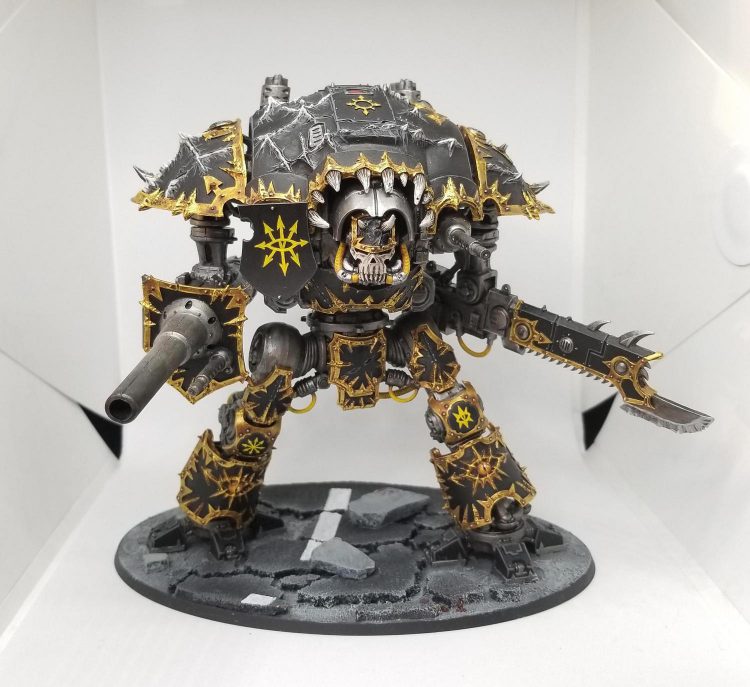
Custom Households
If you don’t like any of those households, Chaos Knights also get some custom options. These are fairly uncomplicated – there are seven ability choices each for Iconoclasts and Infernals, plus a choice each for being an off-brand version of a named house, and you just get to pick one ability for your custom house. These traits do serve a second purpose – they’re also your choices for your Dreadblade traits, so if you’re bringing one of those along you can seed one of these in (and it’s worth thinking about what goes best with other Chaos armies if you’re bringing and Auxiliary Dreadblade.
Iconoclasts get a nice mix of force multiplier effects here, with access to melee exploding 6s from Frenzied Invaders and improved shooting AP and damage on 6s to wound from Precision Cruelty. That latter one could be pretty nasty with chaincannon or lightning lock War Dogs. You also get a way to interact with the Favour of the Dark Gods, with Worthy Offerings boosting your attacks against Monsters, Vehicles and Characters, and meaning that you get to instantly upgrade to your higher level blessing if you destroy any of them, wound count be damned. This one feels like it could be great on a Dreadblade where you’re really baking on the upgrade going off.
Infernal upgrades are a bit more weird and wonderful, though one definitely stands out. Hellforged Construction gives you damage reduction against attacks with S7 or less, which anyone who has played against Ramshackle-heavy armies will know is a very powerful boost. It’s particularly good in melee, as mid-S D2 weaponry is often what armies use to do the heavy lifting here, and can make pushing back against incoming Knights very tricky. It’s also really good on a trio of War Dog Freeblades joining Death Guard, as it prevents you from opening up a vulnerability to autocannon-equivalent weaponry that the army wouldn’t otherwise have. Also highly relevant for Dreadblades is Biomechanical Fusion, allowing one to use Daemonic Surge even though Dreadblades don’t normally get to – a really nice option to have. There are also some general shooting force multipliers, a good anti-Mortal effect in Unhallowed Inscriptions which could be neat into Tyranids, and hilarious comedy option to close out in Dark Forging. This boost shte range of all of your weapons, and then specifically soups up all your stubbers, making them S5 and D2, and letting you ignore Look Out Sir with them. Without AP they’re still not going to get much done, but it’s going to make your opponent very nervous.
It feels like you’re mostly going to use these lists to grab Dreadblade effects, but there’s some nice choices for that, and Hellforged Construction looks like it could break through as an army trait as well.
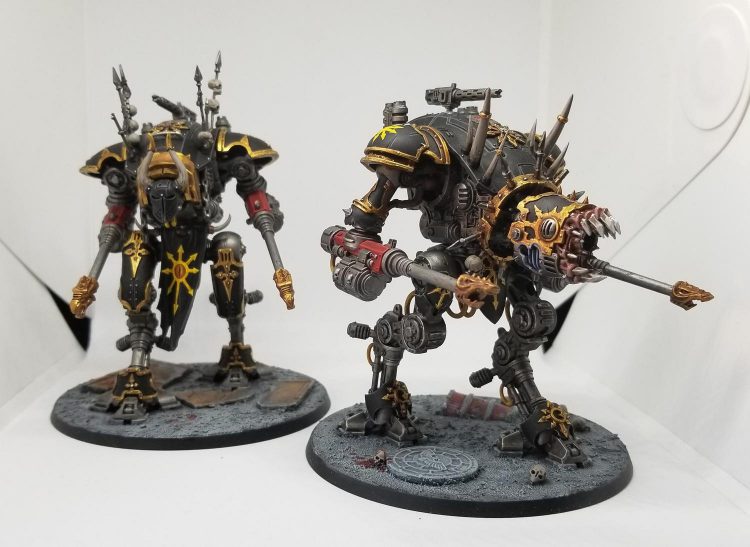
Stratagems
All sorts of different stratagems for Chaos Knights, fitting into a few broad categories. There are some generic offensive and defensive boosts for everyone, lots of tools to allow War Dogs to operate flexibly, one stratagem for each of the Chaos Gods, available to those with a suitable favour (or upgraded with Chosen by the Gods, a new upgrade), and then your upgrade suite.
For generic boosts, Diabolical Bulwark returns as your extra ranged defence, boosting your invulnerable save against shooting to a 4+ (now costing 2CP on Questoris or bigger), and this is joined by probably the most important new stratagem to cover melee, Unyielding Rage. Also costing 1/2CP for Armigers and Questoris+, this gives you -1 to damage against incoming melee attacks for a phase, which is incredible. A huge range of melee heavy hitters rely on D2 and D3 attacks to get stuff done, and this absolutely tanks their output, likely allowing your Knight to survive and swing back for massive damage. This can make planning a fight on multiple fronts super difficult for your opponent – if they charge two Knights with good melee units, you can use this on the first one and tank the assault, the use Counter Offensive with the second to neutralise that combat too. This can result in your opponent having a fight phase where they achieve less than nothing, losing multiple units just to tax you some CP, and the resulting momentum you build can be unstoppable. That massive addition to your suite does get paid for a bit on the offensive front – Trail of Destruction has been toned down, now only providing you re-roll 1s to hit against a target that’s in range of an objective (though dropping in price to 1CP a go, so still usable and pretty good), and Full Tilt is just gone, so Advance and Charge is now very hard to get access to in this book.
Other general use stuff includes boosts for the two big melee weapons, with the reaper chainsword (or chaintalon) getting to trade an extra attack for not being able to re-roll, the warpstrike talon getting a chance to bypass invulnerable saves, and an upgraded version of Spiteful Demise to punish your opponent for killing your stuff. You can now only use this once per game, but the Knight you use it on automatically explodes, potentially taking a huge chunk of the opponent’s army with it. Reliability is king in 40K, and no longer tying this to a 4+ is great. Clutch mortal wounds are also available to the Abominant and the three new War Dog datasheets, which have the right keyword to use the powerful new Ravenous Pterrorshades stratagem. This lets you pick a unit within Dread range in the morale phase, force a Dread test on them, and then inflicts a mortal for each point they fail by (up to six). This is potentially quite huge – it’s swingy as hell, sure, but can do something very rare – mess with enemy attempts to Retrieve Nachmund Data. You can use this in either morale phase, and whatever you target is going to be down at least one point of leadership from your Dread bubble, so even if the opponent only rolls an 8 or 9, they might lose a couple of models from a RND squad, and can suddenly fail the dice roll where previously it was risk free. At 1CP, this can be worth throwing out for a chance of such a critical swing, and it can also be great for messing with how many models an opponent has on an objective just prior to either player’s scoring window.
Moving on to War Dogs, there are all sorts of efficiency boosts for them available, and two key enabling stratagems in Harrying Hunter and Hunting Hounds. Love hunting, those War Dogs. Harrying Hunter isn’t cheap at 2CP, but lets the chosen War Dog Fall Back then Shoot and Charge, ideal for reaching deep into your opponent’s lines, or re-focusing your attention on a different objective. Hunting Hounds is used at the start of your Movement Phase, and allows you to put up to two War Dogs that are within 6” of a board edge into Strategic Reserves, to arrive in a later turn. This is really strong if you go first and your opponent has deployed so you have no good targets, and at 1CP it costs you less than it would to reserve two Dogs anyway. Worth making sure that two of your models have their bases just within 6” of the edge when deploying in case you need to use this.
Moving on to the options provided by the ruinous powers themselves, we should start by covering Chosen of the Gods, which can provide one of the five Chaos Keywords to a model in your army that you haven’t purchased a Favour for for 1CP. Nurgle seems like the most plausible one you might buy here, as their stratagem is generically pretty good to have access to, but in general you’re probably better getting these by picking a cheaper favour. Still, good to have the option. Khorne also makes the Abominant forget how to be a wizard and gain a better melee profile instead, which is funny but not something you should be doing when you could just buy a Knight Rampager instead.
So, once you have the keyword, what stratagems do you unlock? The best here are Nurgles and that from the Pantheon Undivided. Abominable Constitution lets a Knight act on full for 1-2CP (depending on whether they’re a War Dog or something bigger) and that’s always an extremely powerful thing to have access to. The Pantheon, meanwhile, gives you access to one of the swingiest effects out there – once per battle, again for 1-2CP, Beseech the Dark Gods lets a suitably favoured Knight attempt to get back up on 3W on a 4+ after being destroyed. This will be backbreaking when it works, and don’t forget that the unit you’re using this on quite likely has Blessing of the Dark Master, so taking those three wounds off again is actually non-trivial in the late game. Tzeentch’s trick is probably the next best, letting you both automatically wound with a hit instead of rolling and inflict Perils on a Psyker that was hit by the attack for 1CP, nice for messing with Maleceptors. Khorne can also inflict Perils when a Psyker fails a cast, and Slaanesh lets you get extra attacks in melee against big units (OK if there’s a horde that needs to die), but those two definitely feel more like incidental bonuses rather than something you’re actively invested in getting access to.
Lastly, upgrades – extra warlord traits and relics, and Arch-Tyrant to double pick traits for your actual Warlord. One important note here – giving a Knight a relic no longer makes them a CHARACTER, so you only get that keyword (and thus the juicy, juicy heroic intervention) by using Tyrannical Court to add a Warlord Trait.
Pretty good stratagems all-round, though the loss of Full Tilt does bite a bit. However, Unyielding Rage is such a stonkingly good addition to your general toolkit that it goes a long way to making up for it, and some of the god-specific stratagems are also very cool.

Warlord Traits
Six Warlord Traits here that are independent of the household traits. Eager for the Kill gives your knight +1 to advance and charge rolls and +1 Attack in the enemy deployment zone, making it a good fit for Undivided knights who deep strike around the table. Warp-Haunted Hull lets your knight deny as if it were a Psyker, or gives it +1 deny if you were already psychic, and on top of those effects, it gives you a 5+ against mortal wounds. Great for seeding in a little bit of Psychic defence in the current metagame. Another metagame-dependent choice is Harbinger of Scrapcode, letting you bully enemy Vehicles. You pick one in Dread range in each Morale phase, and make them take a Dread test. If they fail, they take three Mortals and have their wound count halved till the next morale phase for stat purposes (or get tanked a point of WS and BS if they don’t degrade). The fact this goes off on both players turns makes it quite scary to play around, and if Knights take off this feels like it could give you the leg up on other armies.
Moving on to the two that’ll probably see most use from this list, we have returning champions Infernal Quest and Knight Diabolus. These aren’t complicated – Quest provides ObSec, Diabolus provides an extra attack and re-roll 1s to hit in melee – but both effects are so good and so in line with what you want to be doing on the table that they’re hard to pass on.
Last on the list is Aura of Terror, playing with the new Dread mechanic by making your opponent roll an extra d6 and discard the lowest for Morale or Dread tests while in Dread range. This is quite a bit stronger than it looks – morale tests in general start mattering way more against this army than any other, and this is especially strong with Gheist Storm, making it very easy for your opponent to trip and fall and fail to do anything.
Two obvious slam dunk picks, and several interesting options if you’re feeling like taking a third and don’t fancy your Household’s overall.
Relics
You get a bit of everything from the Chaos Knight relic section, and it feels like most of the stuff here could be fun to take out for a spin. As a note, similar to the Imperial Knights, most of these now cannot be taken on a Tyrant Class Knight (with The Traitor’s Mark and the Rune of Nak’T’Graa being the only exceptions), so what you see is mostly what you get on those.
First up, weapons – there are relic upgrades for both big melee weapons plus the Desecrator’s laser destruction. All three are very good – the Gauntlet of Ascension gives full melee hit re-rolls plus extra attacks when you kill enemy characters, the Teeth that Hunger are worth an extra attack and +2S over a regular reaper chainsword, and the Diamonas gets an extra shot and S16, perfect for the mirror match. All three are extremely viable picks if you have the relevant baseline weapon. Also good for boosting your output is the Helm of Dogs, a War Dog-only relic that provides the bearer with an extra attack, and a re-roll one aura for wounds for nearby War Dogs. Extremely potent in a list that’s heavy on them.
Next up, defences – Iconoclasts get the powerful Veil of Medrengard here, granting them a 4+ invulnerable save against shooting and a 6+ in melee, ideal if you want to create a super-tough wrecking ball to send into your opponent’s lines. Chaos also now get their own version of the Armour of Sainted Ion in the Panoply of the Cursed Knights for a flat 2+ save. Not complicated, but very welcome. Infernals also get an option in this rough space, with the Blasphemous Engine letting them act as if they had double their current wounds remaining, and ignore wounds from Daemonic Surge on a 2+, which is a nice extra bonus.
Finally, some utility stuff. The Twisted Mark is an excellent upgrade for an Abominant, giving them +1 on casts and an extra known power, never something to sniff at, while if you want a more all-rounder boost for a Knight you can take the Tyrant’s Banner, providing boosted Aura ranges and a chance to gain an extra CP in your command phase. If you like playing with Dread abilities then The Traitor’s Mark is very cool – this makes dealing with Dread far harder in general by preventing the opponent using Insane Bravery or re-rolling Morale tests in the range of the bearer, and once per battle the bearer can also pick a second Dread ability from the relevant ones for the turn, gaining it for the rest of the battle. This can be great on a Knight that you’re going to send on a rampage into the opponent’s lines – even on turn two, just adding Creeping Dismay or Encroaching Doom makes the Knight a better utility piece for the rest of the game, and later on it can mean you can benefit from both the defensive and a utility option in the same round.
The last pick of note is the Rune of Nak’Ta’Gra, which is for a Dreadblade only. This lets you take a second Fell Bond, which is really cool, and more of a motivation to maybe consider taking one as part of a full Chaos Knight army. It does highlight that it would be cool if there was some way to to get a relic onto a Dreadblade when taking one alongside another force (they’re unlikely to be your Warlord most of the time, as doing so would mess up Secondary and Relic access for your main army), but it’s nice that this encourages wider use of Dreadblades elsewhere.
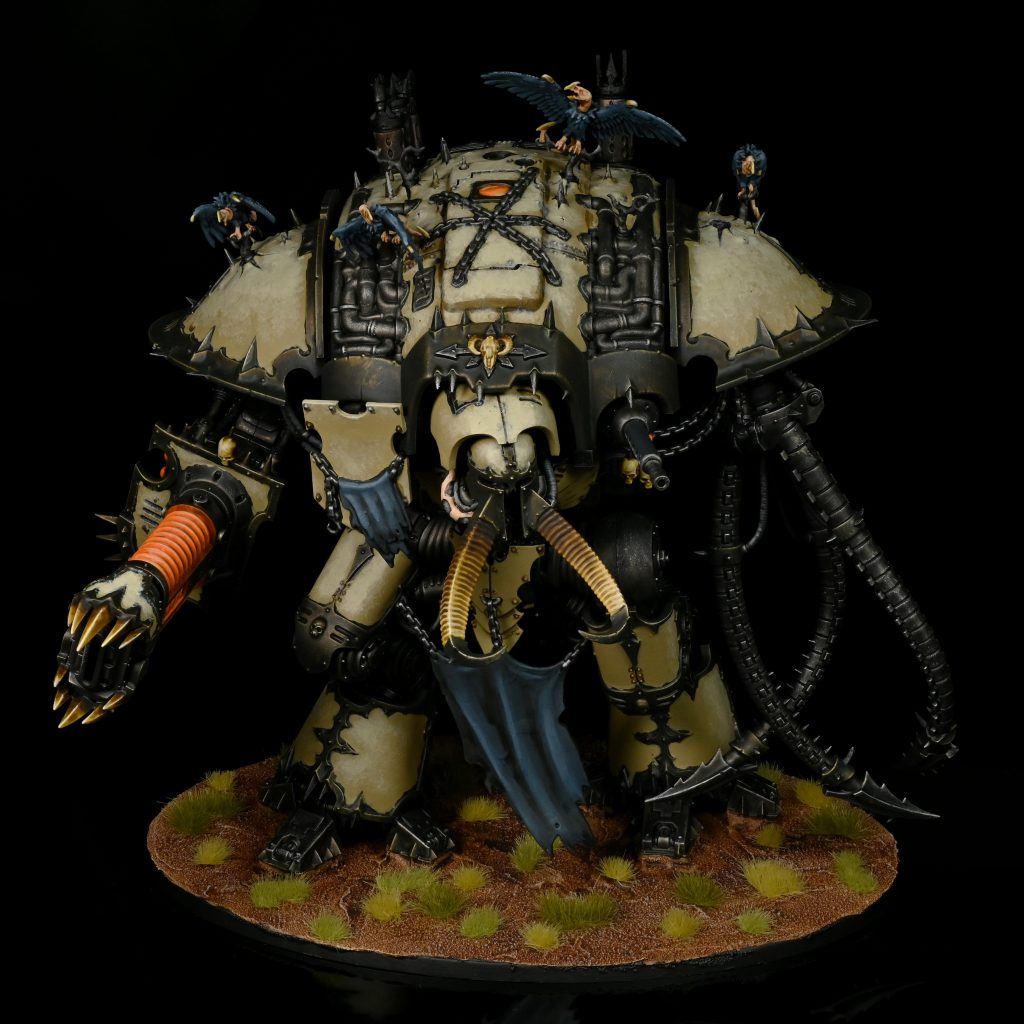
Warp Storm Discipline
Chaos Knights get to bring a muscle wizard of their very own now in the form of the Abominant, (and can also create one via the Pyrothrone of Tzeentch upgrade) and wizards need powers to pick from. That’s what the Warp Storm discipline provides, and there’s some real goodies in here.
The first power is probably the initial standout, and you’re very likely casting this almost every turn that you have an Abominant on the table. Winds of the Warp provides the caster with a 5+ to ignore wounds, and also a 6+ aura of the same for War Dogs if they rolled high enough on the cast. That latter bit is nice, but just the 5+ is incredible on a model as tough as a Knight. You can stack stuff on an Abominant to make them almost unkillable, and this is a big part of that plan. The other big standout is The Storm Malevolent, picking an enemy unit within 18” and giving all Chaos Knight units +1 to wound against it in melee, plus a chance to do mortals on 6s. +1 to wound is an amazing buff, and happens to work extremely well with the Abominant’s own melee attacks, which are high in volume with good damage, but “only” S8. Also good for allowing a pack of War Dogs to turn something into paste.
Given how strong these powers are, and that you get two picks by default on an Abominant, you’re likely taking them over the rest of these most of the time. If you get an extra power from The Twisted Mark, or just like melting faces, Coruscating Hate is probably your damage dealer of choice – a Smite that has a chance to bounce on to a second target. Spitesquall and Cyclonic Lamentation provide other ways to throw out mortals either against large units or in a wide area, and Vortex Terrors limps in at the end as a relatively mild debuff.
Don’t think too hard about this, to be honest – pick Winds of the Warp and The Storm Malevolent and the Abominant becomes an amazing unit.
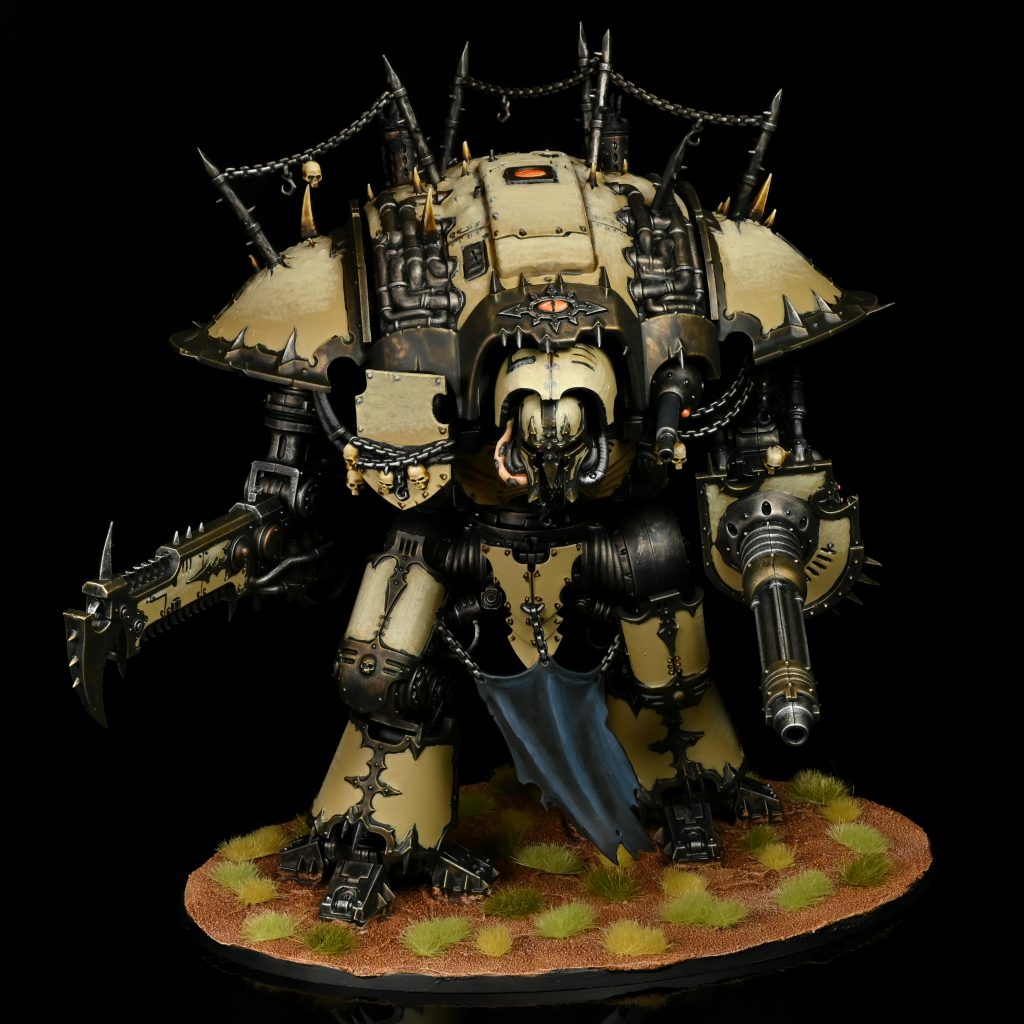
Secondary Objectives
Chaos Knights get four Secondaries, one each in every category except Warpcraft, and like those given to their Imperial counterparts, these should go a long way to solving some of the army’s issues with picking these.
Leading the charge is A Fitting Challenge, a handy Purge the Enemy option that you can pick in any matchup, exactly what you needed. When you select this, the opponent’s three most expensive units become targets that must die, and you get points based on when you kill them. You can score up to 6VP per Battle Round, and get 6VP for killing a target in the first battle round, 5VP in the second etc. That means that to max this your goal is to kill one target unit in each of the first three turns of the game – if you double up, you’ll hit the point cap. If any of the targets survive the battle, you also lost a point for each at the end of the game. While this is certainly not a freebie, what it is is a reliable way to score around 10VP for just sticking to your normal plan, with the option to go higher if the game swings your way fast, and that’s useful to have as an option in this category.
Note: The wording here has a typo that makes it look like you keep scoring points for a unit that was killed for the rest of the battle, which would mean that killing a target in the first battle round would just automatically maximise your score. Luckily, there’s a worked example included in the rule that makes it clear that this isn’t the case, and clearly outlines the proper functioning.
The other key category you couldn’t previously cover is Shadow Operations, and here the new Storm of Darkness secondary has you covered. This gives you an Action running from the Morale Phase to the end of your next Movement Phase that lets you curse an objective that you’re in range of with one of your units, and no enemies are near. Each one you pull off gives you 3VP, and the objective also becomes spooky for the rest of the battle, giving non-Chaos units -1Ld. This is OK – it’s probably not as good as Imperial Knights new Renew the Oaths option as your opponent has some scope to meddle with it, but it has the upside that it doesn’t need you to give up any shooting to pull it off (and indeed you can get into position to start it by charging onto an objective and killing everything on it). As written, you can also start this in your opponent’s Morale Phase, allowing you to pull off two ticks in a turn (though maybe don’t expect that to survive an FAQ pass). Still, even if that changes you should be able to muscle this to 9VP fairly reliably, and given this was a dead category for Chaos Knights before, that’s handy.
The other choice that’ll see use here is Ruthless Tyranny, which is essentially a vastly superior Stranglehold that’s much easier to pull off on six objective maps. You’ll probably only use it when six objectives are in play, or your opponent has a big vulnerability to a kill secondary so you don’t need to use A Fitting Challenge or Storm of Darkness, but it’s extremely good when you use it.

The Units
Chaos Knights have come a long way since that pamphlet in mid-2010s first introduced their rules. With this new book they’ve achieved a much more visually distinct feeling, and thanks to the introduction of the new psychic knight abhorrent, they feel like a fully different faction to Imperial Knights.
General
Knights are all terrifying warriors with a good BS/WS of 3+ and 4A (with a few getting some extra boosts), and have three basic defensive statlines, corresponding to each of the three classes:
- The War Dog is your light Knight – you get up to three in a unit, which have to deploy within 6” of one another but then independently from there. They’re equivalent to the mid-tier walkers of other factions, with T7 and 12W. They’re also nippy with a 12” movement.
- Abhorrent Class Knights are the classic Lord of War, covering both the traditional Knight Despoiler and the Chaos-specific ones with the extra-joined lets. These sport 24W and T8. They move 10”.
- Tyrant Class Knights are heavy duty engines of war, keeping T8 and going up to 28W and a 2+ save. They’re a bit slower at 8”, and also only get WS4+ due to being a bit cumbersome.
The new book pushes the Chaos-specific knights quite a bit, but the Despoiler still draws from the standard weapon list, so go take a look at the Imperial Knights review to get a view of what their various guns do. In addition, like Imperials, the titanic feet weapon no longer multiplies your attack, so you’re generally encouraged to take a melee weapon where possible to keep flexible. Luckily, all the Chaos-specific Knights are very much bought into this plan!
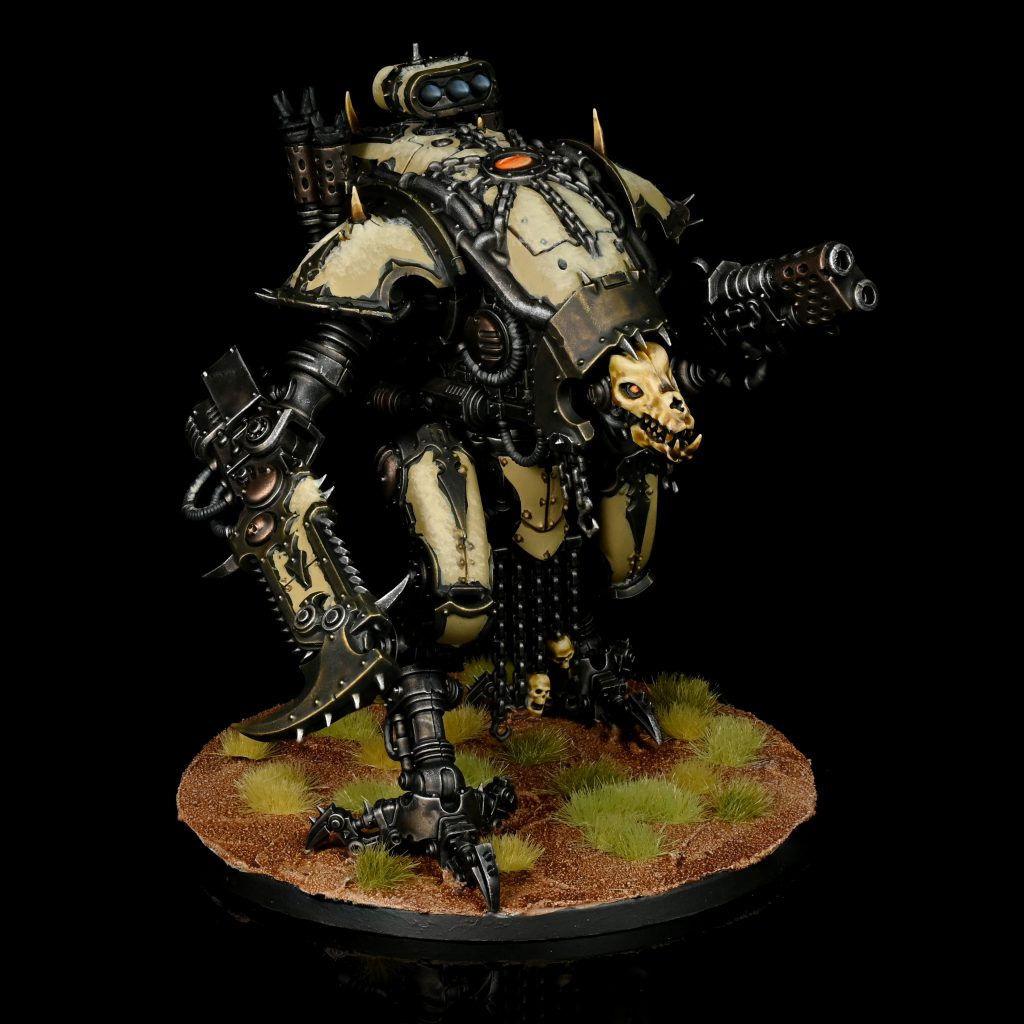
Lord of War
Apparently Chaos let the dogs out (Rob: Booooo …who wrote this?), because there are five different War Dog datasheets available here. You get the two “classic” War Dog options, the Executioner with autocannons and Huntsman with the melta and chaintalon, and these are much the same as always, with slightly improved weaponry for the new book. The Executioner is still fine if you want a Knight to snipe from the back, but there’s now almost no reason to ever take a Huntsman.
This is because of the War Dog Stalker, the new mixed melee/shooting War Dog from the new box. This can take either a slaughterclaw (spicy S12 D3+d3 attacks) or a chaintalon on one arm, and any of either a daemonbreath spear (the Huntsman’s melta weapon) or the new avenger chaincannon on the other. It also has a different option for its top gun, being able to upgrade to a havoc launcher for a small amount of indirect instead of having the melta option of the classic War Dogs. This means that at the same price as a Huntsman you can take the exact same main weapon loadout, just with the PTERRORSHADES keyword on top, so you should basically always do that. The chaincannon is also an extremely legitimate option, firing at H12, S6 AP-2 D1, providing some nice, broad firepower that can scythe through targets like aspect warriors at pace. It feels like this should see a lot of use, as it really helps broaden your shooting in some matchups.
If you can’t decide between the guns and want a mid-board dakka loadout, you also have the option of taking the new Brigand, which eschews melee to take the melta and the chaincannon, at a slightly higher price tag. If you can’t decide between the guns, but think guns are for cowards, your final option is the Karnivore, an all-melee Knight with both melee options that compensates for the lack of shooting by being cheaper, faster and far deadlier, at WS2+ and 5A. These are a nightmare if they get into any valuable targets, and taking one to help make your points add up, and perhaps using a Favour of the Dark Gods to make them extra spicy, seems very reasonable, with the Blood Shield and Quicksilver Throne seeming particularly promising.
Moving up the hierarchy, the Knight Despoiler remains your swiss army knife Knight datasheet, able to take almost any combination of Questoris weapons, including doubling up on the same gun, and also letting nearby War Dogs heroically intervene as if they were CHARACTERs. You’re probably not going to see these that often, if we’re honest, as taking double guns is no longer a particularly great option, but the daemonbreath cannon/melee option is perfectly serviceable if you don’t have a role for one of the Chaos-specific builds.
Let’s look at those next, starting with the Desecrator, who is now extremely pushed (and a big culprit in why you won’t see many despoilers around). These only run you 400pts, the cheapest way to get a gun/melee knight across either book, and their laser destructor is now far more of a real gun – its damage has gone from d6 with a chance of d3 mortals to 6+d3, which is quite the jump, and makes taking the Diamonas relic for a third shot much more awesome. It also gets base WS2+, and provides a re-roll 1s to hit aura for War Dog shooting, making the complete package here a very high value all-rounder. For melee, you have the Rampager, a direct equivalent to the Gallant of the hated loyalists, being faster and having WS2+ and 5A for maximum chopping. They also boost War Dogs with re-roll 1s to hit in the fight phase.
Joining these two to complete the terrible triumvirate of terror is the new Abominant, which is really, really good. Weighing in at 430pts, it comes with some whole new equipment, plus two powers from the Warp Storm discipline (and one deny). The volkite combustor is a pretty swingy gun, hitting at S10 for three damage (plus three mortals on 6s to wound), but only at AP-1. In the age of the new Armor of Contempt rule, AP-1 really hurts, so you are mostly hoping for the 6s to wound to carry some mortals, but this is still pretty broadly strong. Melee is where it’s really nasty though – it only has three attacks base, but the combination of the Electroscourge and Balemace (which is the tail, we were confused initially too) still makes it one of your deadliest fighters. The Electroscourge provides that most potent of things – a sweep attack that hits at flat three damage, while the Balemace adds d3 additional attacks at D2. The scourge is the big winner here, as on just the baseline of nine hit rolls with it it’s great, and it makes any effect that adds more attacks (such as the Iconoclast trait) really good on this Knight. Don’t forget that you can give it +1 to wound very easily with a power too. Round out with the ability to pick up a 5+ ignore wounds with Winds of the Warp and you have a new all-star, especially as Iconoclasts where the scourge is extra strong.
Finally, Tyrants – mostly the same as before, and the Chaos datasheet still covers both variants, (though no mixing and matching their weapons, nice try). Biggest changes here are that is now comes with a 2+ save stock, and the Castellan build gets profile changes to both the Volcano Lance and Plasma Decimator. The Plasma gained damage and strength, in that the base profile is S8 2D and supercharge for S9 3D, but now the supercharge deals 2 mortals for each hit roll of 1. It is nice that the Chaos side now has access to what essentially used to the Cawl’s Wrath statline. The Volcano lance took a hit in the number of shots with a gain in damage, making it a bit more swingy now, D3 shots at S16 AP-5 d6+8D – still terrifying for the opponent, but a higher chance of whiffing entirely. The Valiant’s weaponry hasn’t changed, but it is a big winner from access to Blessing of the Dark Master, enabling some superlative rampages if not stopped. However, both builds do suffer quite a bit from no longer having titanic feet multiply their melee attacks, making them quite vulnerable if charged. They can, obviously, fall back and operate without penalty, but you have to work a bit harder to get value from them.
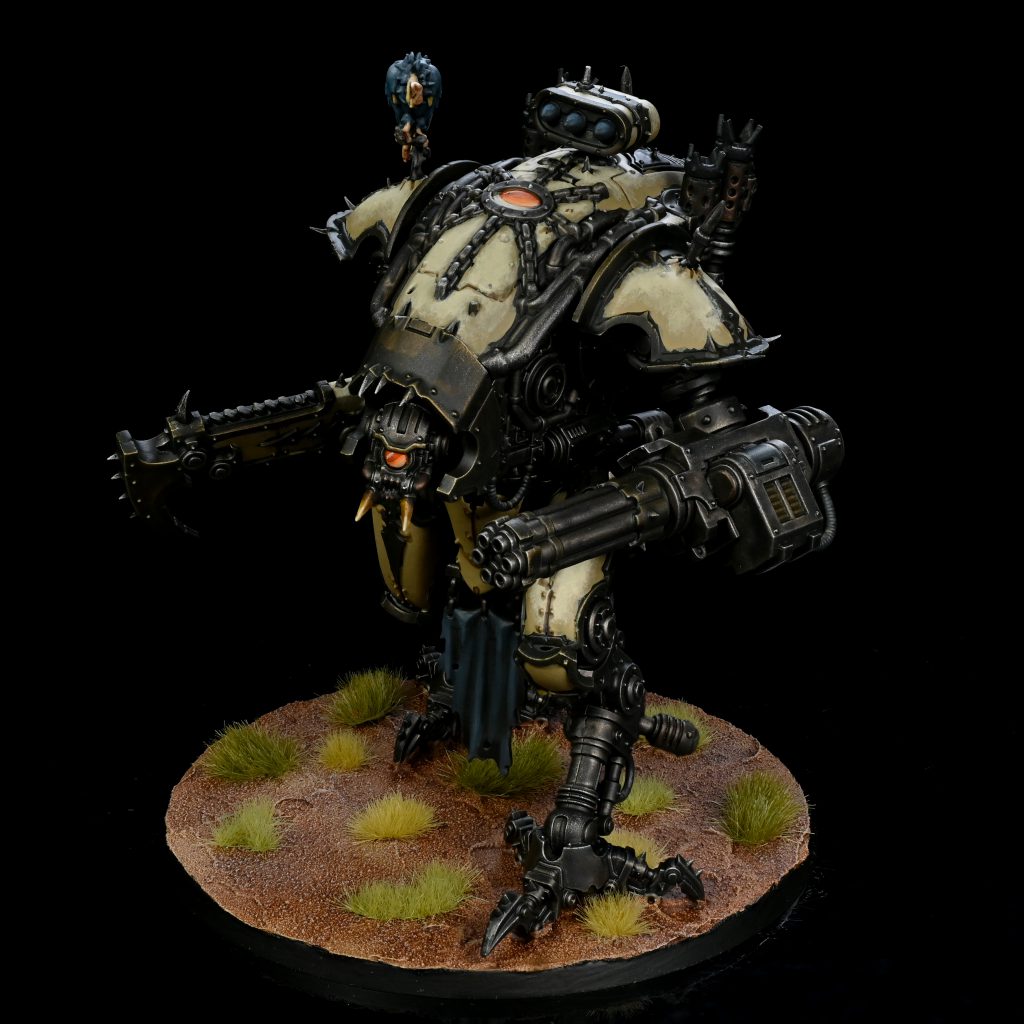
How They’ll Play
TheChirurgeon: There are really two things to consider here – one, how they’ll play as a standalone force, and the second being how they’ll improve or interact with existing Chaos armies. As a standalone force, I think Chaos Knight armies will tend toward large groups of War Dogs with 1-2 big knights. The Abominant seems like a must-take in many of these armies, if only for Winds of the Warp, which is just an incredibly good psychic power on a knight model, effectively giving it 50% more wounds and boosting the war dogs you keep around. The problem Knights are going to face is just how incredibly deadly shooting is – and I’m not even talking about T’au. Yeah, sure Stormsurges and Hammerheads could be a problem, but loads of Tyranid mortal wounds and Venom Cannons are going to be just as big an issue to navigate, especially when you can’t hide behind walls. That’s another reason I expect to see more War Dog-heavy lists, with 1-2 big knights, though the Knight Tyrant just has so much output and can become so durable that it may be worth including one anyways and daring your opponent to do something about it. I think Shane’s on that train of thought with his list (see below). It’s also notable that I think we dodged a bit of a bullet here with the Dataslate nerfs to indirect fire, as having D6 indirect havoc shots on most of your war dogs was going to make them insufferable otherwise.
When it comes to adding in Dreadblade detachments to existing chaos armies, it’s hard to imagine a Thousand Sons, Chaos Marines, Death Guard, or Daemons army that doesn’t want a trio of ObSec War Dogs running around, particularly the Executioner, which may be boring in that it’s something we’ve already seen but 4D3 autocannon shots putting out 3 damage each is just too good to ignore. Thousand Sons and Death Guard have been struggling a little bit to figure out what goes into their army after the 20 ObSec Terminators, and for the former Armour of Contempt basically made Forgefiends worthless (they were already marginal to begin with). There’s also likely play for a House Korvax / Be’lakor Army of Renown list in there somewhere, though there’s very little synergy between the dark master and the knights overall. You’re essentially going to add either a war dog trio or a knight tyrant with Blessing of the Dark Master to make yourself insufferably difficult to kill.
On the whole I expect Chaos Knights to be below average competitively as a standalone army, but potentially better than Imperial Knights, while I expect the ability to add a Dreadblade detachments to make other Chaos armies stronger. The added versatility and mobility you get from the ObSec War Dogs just seems really good to me, but I also wouldn’t be shocked to see a single Tyrant showing up in some lists.
Army Lists
Shane’s House Korvax Infernals
House Korvax Super-Heavy Detachment
LOW: Knight Tyrant w/volcano, 2xdesecrator, blessing of a thousand poxes 640
– extra relic, rune of darkness
LOW: Knight Abominant w/blessing of the dark master 460
– winds of the warp, storm malevolent
– warlord, arch tyrant, knight diabolus, infernal quest
– panoply of the cursed knights
LOW: 3x stalker w/chaincannon, chaintalon, 2x havoc, 1x stubber 445
LOW: 1x stalker w/chaincannon, chaintalon, havoc, mirror of fates 165
LOW: 2x karnivore w/havoc 290
2000pts, 10CP
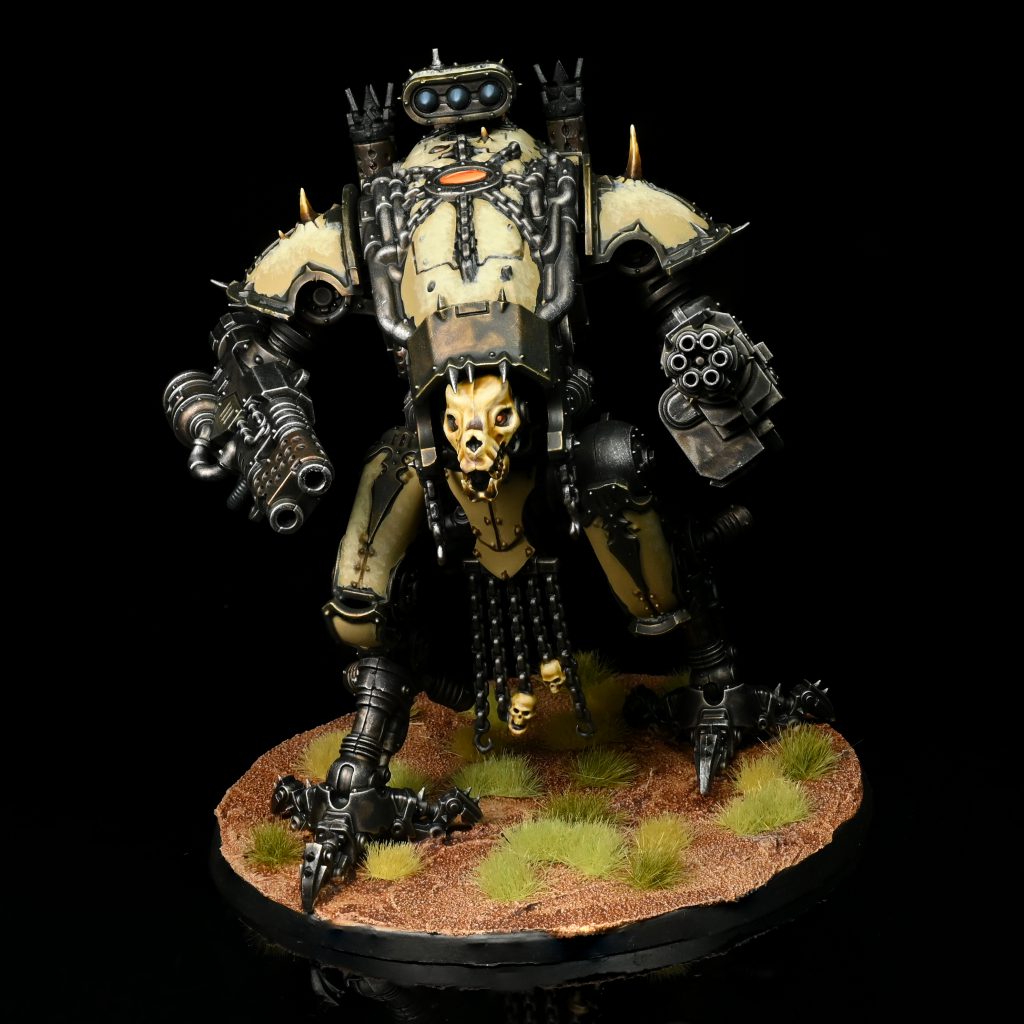
Wings’ House Herpetrax
I’ve mostly been focused on the Imperial Knights, but I had time to test run some of the Chaos rules into a Drukhari force run by Corrode, and very much enjoyed how the faction plays. I’ve tweaked the list a bit from what I ran, as Shane has already shown off the power of a Tyrant with Thousand Poxes, and the list I used ended up being down 3CP in order to squeeze it in anyway. After revisions, this is what I’d play:
House Herpetrax Super-Heavy Detachment
LOW: Knight Despoiler, daemonbreath cannon, havoc missile pod, reaper chainsword, Nurgle: Putrid Carapace, Extra trait: Bow to None – 485pts
LOW: Knight Desecrator, Warlord: Infernal Quest, Diamonas, warpstrike talon, Tzeentch: Cursed Rune of Fate – 435pts
LOW: Knight Abominant, Blessing of the Dark Master, Extra Trait: Knight Diabolus, Extra Relic: Veil of Medrengard, Winds of the Warp, The Storm Malevolent – 460pts
LOW: 3x War Dog Stalker, 2x Havocs/Chaincannon, 1x Melta/Stubber, Tzeentch: Mirror of Fates on one of the Chaincannons – 460pts
LOW: War Dog Karnivore, Quicksilver Throne, Havoc Launcher, Extra Relic: Helm of Dogs – 160pts
2000pts, 8CP
This list goes hard on pressure – the basic plan is to make the Abominant nigh-unkillable, then launch them at the opponent as a wrecking ball, using their huge number of swings on the charge to carve through whatever gets in the way. The next wave is the War Dogs with the Desecrator, whose goal is to snipe out some sort of 10W target with the Diamonas, then get stuck into battle with a 4+ invulnerable save once fully favoured. The Karnivore acts as a lethal counterpunch unit if the opponent tries to push back, and can lurk in a ruin while still adding re-roll value to the rest of them. Finally, the Despoiler can initially stay back immolating anything that emerges into the mid-board, and has the option to sally forth into battle if needed towards the end of the game.
I found that the Herpetrax extra wounds were really good, significantly outperforming how they looked on paper, especially as they don’t change the break points for stat changes – it really helped keep the hated Drukhari under pressure throughout the game. The Iconoclast trait is also as strong as ever, and great fun with the improved statlines on a lot of melee weapons.
Wrap Up
Overall, Chaos Knights seem like a fun army to play, but it remains to be seen if they’ve got the power to punch through the disadvantages of being all-Lord of War in the very hostile metagame. They match up well – and in interesting fashion – against Imperial Knights, and the armies do finally feel like distinct and varied forces. The flavor of being able to mark your knights and dedicate them to the dark gods is great, and the new boxed set is a great value that has us excited to get started with the army.
Have any questions or feedback? Drop us a line in the comments below or email us at contact@goonhammer.com.
